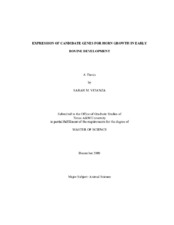| dc.description.abstract | Bovine horns develop primarily after birth and the presence or absence of horns
is due to a single gene. It has been reported that the horn bud appears in the bovine
embryo at d 60 of gestation. Our hypothesis is that the gene that determines the presence
of horns is expressed in osteoprogenitor cells of the early fetus and will affect the
expression of RUNX2, MSX1, MSX2, and/or TWIST1.
To test this hypothesis, bovine fetal samples were collected from commercial
females at the Caviness Packing Company in Hereford, Texas. Fetuses ranged from d
28 to d 80 of gestation. A survey of the expression of genes from the region on bovine
chromosome 1 known to contain the locus that causes horns (IFNAR1 to SOD1), was
conducted using qualitative and quantitative RT-PCR, and in situ hybridization. Genes
with known roles in osteogenesis and chrondrogenesis (MSX1, TWIST1, RUNX2 and
SOX9) were included as positive controls.
With the exception of OLIG1, which was only expressed in the brain, all of the
genes investigated were expressed in fetal frontal and parietal bones by qualitative RT-PCR. The level of expression of C21orf59, C21orf66, IL10RB, and SFRS15 increased in
the frontal bone of horned samples from d 55 to d 70 of gestation.
At d 60 of gestation, a change in the shape of the frontal bone was observed,
which has been reported to be the developmental stage when the horn bud appears. At
this time point, MSX1, TWIST1, RUNX2 and SOX9 were detected in frontal bone, in cells
from the osteoblast lineage, as expected. Furthermore, C21orf59, C21orf62, C21or66
and SFRS15 from the polled interval were localized to developing mesenchyme,
osteoblasts and/or osteoclasts of the frontal bone, suggesting that each of these genes has
a role in intramembranous bone formation. In addition, gradients of expressed C21orf66
and SFRS15 were detected in developing endochondral bone. There was evidence of an
antisense transcript of C21orf66 expressed in the same cell types as the sense transcript.
Further characterization of this antisense transcript demonstrated that it covered the
entire sense transcript. Based on observed expression in the mesenchyme, rather than
just in mature osteoblasts or osteoclasts, C21orf66 and/or its antisense transcript become
the most likely candidates for the polled locus. | en |


